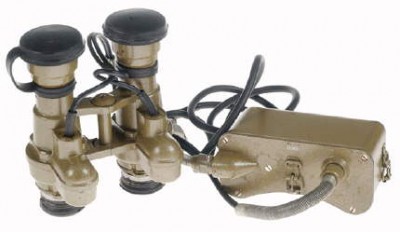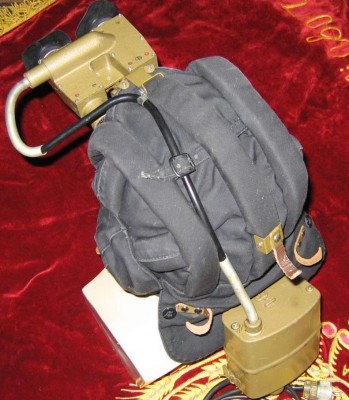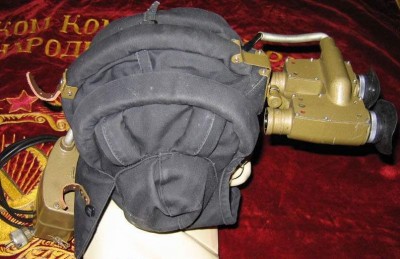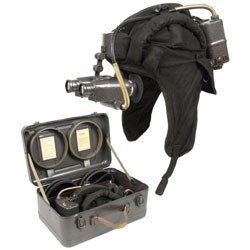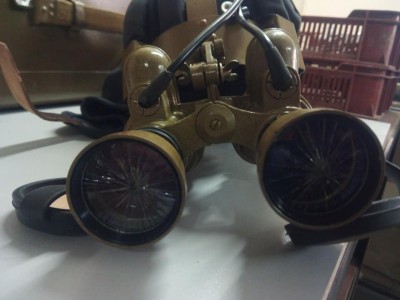Binocular infrared PNV- 57 is designed for drivers of automobiles , tracked and wheeled artillery tractors , amphibious automobiles , tracked amphibious transporters and motor tugboats at night .
Infrared device for car drivers works on the principle of using reflected infrared rays . The headlights of the vehicle with infrared filters emit a beam of infrared rays on the road, the observed terrain . Part of these rays are reflected from the road (the observed terrain) and the objects that are on it . The lens of the infrared instrument concentrates the reflected infrared rays that have fallen on it and creates on the photocathode of the electro-optical image converter , an infrared inverted image of the road and objects .
The photocathode consists of a layer of semi-transparent special substance deposited on the inside of the electro-optical image converter. This layer emits electrons from the irradiated points , with the amount of electrons emitted from each point being directly proportional to the irradiation intensity of that point . In this way, the photocathode converts the infrared image into an electron image. This means that in an electro-optical image converter, the infrared image is first converted into an electron image ( on the photocathode ) and only then is this converted into a visible image (on the shield).
This visible image is similar in appearance as well as in brightness distribution to the observed object (the road and objects on it).
The observer does not observe the image of the object directly on the shade , but only through the eyepiece . The necessity of using an eyepiece is that the lens and the electro-optical image converter on the shade are very small . In order to create a normal perception of the observed object in the eye , the shade is observed with an eyepiece , which magnifies the image to normal size . In the PNV -57 infrared instrument there are two electro-optical arrays , one for each eye. This arrangement of the observation systems is called binocular . It creates a certain spatiality of the image , thus achieving a true perception of the observed objects . The disadvantage of this infrared instrument is that it uses an illuminating body , headlights , a vehicle with infrared filters , which emit a beam of infrared rays to operate. It is an active device in its operation is easily detectable by the means of the adversary .
This apparatus , but in the modification of the designation PNV -57 DP is also used for drivers of engineer transport vehicles and for vessel transport . It differs in that it is supplemented by a special infrared illuminator and its fixing device , which are housed in a special housing .
PNV -57 infrared light source accessories:
- low voltage cable
- high voltage cable
- supply cable
- infrared filter
- sensing frames
- box with sealant
- replacement joint parts
- lens covers
- infrared instrument
- hood
- high voltage power supply
- crate
- recorder
Technical parameters:
field of view . . . . . . . . . . . . . . . . . . . . . . . . . . . . . . . . . . . . . . 30°
magnification . . . . . . . . . . . . . . . . . . . . . . . . . . . . . . . . . . . . 1x - 1.2x
Maximum resolution:
center of field of view . . . . . . .. . . . . . . . . . . . . . . . . . . 35 lines per min.
eyepiece diopter adjustment . . . . . . . . . . . . . . . . . . . . . +- 4 diopters
Voltage : input . . . . . . . . . . . . . . . . . . . . . . . . . . . . 12V or 24V
Output . . . . .. . . . . . . . . . . . . . . . . . . . . . 14kV - 19kV
weight of the kit in the housing . . . . . . . . . . . . . . . . . . . . . . 9.3 kg
infrared radiation source . . . . . . . . . car headlights
(BVP with infrared filters)
fixing point . . .. . . . . . . . . . . . . . . . . . . . on the back of the hood
Basic technical data of the infrared lamp:
axial luminous intensity (with diffusing glass) . . . . . . . . . . . . . . . 127 550cd
scattering task :
Vertical . . . . . . . . . . . . . . . . . . . . . . . . . . . . . . . . . . . . . . . 3° to 4°
horizontally . . . . . . . . . . . . . . . . . . . . . . . . . . . . . . . . . . . 10° to 11°
radiation source . . . . . . . . . . . . . . . . . . . . . . . . . . . . . . .
wattage . . . . . . . . . . . . . . . . . . . . . . . . . . . . . . . . . . . . . . 100W
diameter of reflecting mirror . . . . . . . . . . . . . . . . . . . . . . . 250mm
Infrared device for car drivers works on the principle of using reflected infrared rays . The headlights of the vehicle with infrared filters emit a beam of infrared rays on the road, the observed terrain . Part of these rays are reflected from the road (the observed terrain) and the objects that are on it . The lens of the infrared instrument concentrates the reflected infrared rays that have fallen on it and creates on the photocathode of the electro-optical image converter , an infrared inverted image of the road and objects .
The photocathode consists of a layer of semi-transparent special substance deposited on the inside of the electro-optical image converter. This layer emits electrons from the irradiated points , with the amount of electrons emitted from each point being directly proportional to the irradiation intensity of that point . In this way, the photocathode converts the infrared image into an electron image. This means that in an electro-optical image converter, the infrared image is first converted into an electron image ( on the photocathode ) and only then is this converted into a visible image (on the shield).
This visible image is similar in appearance as well as in brightness distribution to the observed object (the road and objects on it).
The observer does not observe the image of the object directly on the shade , but only through the eyepiece . The necessity of using an eyepiece is that the lens and the electro-optical image converter on the shade are very small . In order to create a normal perception of the observed object in the eye , the shade is observed with an eyepiece , which magnifies the image to normal size . In the PNV -57 infrared instrument there are two electro-optical arrays , one for each eye. This arrangement of the observation systems is called binocular . It creates a certain spatiality of the image , thus achieving a true perception of the observed objects . The disadvantage of this infrared instrument is that it uses an illuminating body , headlights , a vehicle with infrared filters , which emit a beam of infrared rays to operate. It is an active device in its operation is easily detectable by the means of the adversary .
This apparatus , but in the modification of the designation PNV -57 DP is also used for drivers of engineer transport vehicles and for vessel transport . It differs in that it is supplemented by a special infrared illuminator and its fixing device , which are housed in a special housing .
PNV -57 infrared light source accessories:
- low voltage cable
- high voltage cable
- supply cable
- infrared filter
- sensing frames
- box with sealant
- replacement joint parts
- lens covers
- infrared instrument
- hood
- high voltage power supply
- crate
- recorder
Technical parameters:
field of view . . . . . . . . . . . . . . . . . . . . . . . . . . . . . . . . . . . . . . 30°
magnification . . . . . . . . . . . . . . . . . . . . . . . . . . . . . . . . . . . . 1x - 1.2x
Maximum resolution:
center of field of view . . . . . . .. . . . . . . . . . . . . . . . . . . 35 lines per min.
eyepiece diopter adjustment . . . . . . . . . . . . . . . . . . . . . +- 4 diopters
Voltage : input . . . . . . . . . . . . . . . . . . . . . . . . . . . . 12V or 24V
Output . . . . .. . . . . . . . . . . . . . . . . . . . . . 14kV - 19kV
weight of the kit in the housing . . . . . . . . . . . . . . . . . . . . . . 9.3 kg
infrared radiation source . . . . . . . . . car headlights
(BVP with infrared filters)
fixing point . . .. . . . . . . . . . . . . . . . . . . . on the back of the hood
Basic technical data of the infrared lamp:
axial luminous intensity (with diffusing glass) . . . . . . . . . . . . . . . 127 550cd
scattering task :
Vertical . . . . . . . . . . . . . . . . . . . . . . . . . . . . . . . . . . . . . . . 3° to 4°
horizontally . . . . . . . . . . . . . . . . . . . . . . . . . . . . . . . . . . . 10° to 11°
radiation source . . . . . . . . . . . . . . . . . . . . . . . . . . . . . . .
wattage . . . . . . . . . . . . . . . . . . . . . . . . . . . . . . . . . . . . . . 100W
diameter of reflecting mirror . . . . . . . . . . . . . . . . . . . . . . . 250mm
